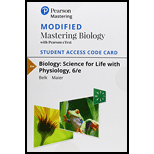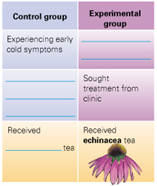
Add labels to the figure that follows, which illustrates the characteristics of research participants in control versus experimental groups.

To fill up:
The figure that gives the features of research participants in between the control and experiments groups of a scientific hypothesis:
- Control group (a) experiencing the early cold symptoms. (b) ____________ and received (c) _________ tea.
- Experimental group (a) __________, (b) sought treatment from clinic, and (c) received echinacea tea.
Introduction:
A scientific control experiment can be defined as an observation or experiment which is designed to decrease the effects of the variable other than the self-governing variable. This raises the reliability of the results usually through an evaluation between the control and other measurements.
Explanation of Solution
An experimental group can be defined as the group which performs an experiment which receives the variable being verified. One variable is confirmed at a time. The experimental group is associated with a control group. Control group does not receive the test variable. Thus, the experimental groups are used to identify the answers in an experiment.
The table gives the features of research participants in between the control and experiments groups:
| 1. Control Group | 2. Experimental Group |
| experiencing the early cold symptoms | experiencing the early cold symptoms |
| sought treatment from clinic | sought treatment from clinic |
| Received placebo tea | received echinacea tea |
The given table shows a study that describes and support the hypothesis. In this hypothesis, the echinacea tea decreases the severity of colds. Using some placebo tea makes only a single reliable difference between the individuals in the two groups. In the echinacea tea experiment, the severity of cold was lower in the experimental group than those who have received a placebo.
Though, it is very rare that a single experiment will remove all the probable and different explanations. This makes the scientific community to admit a hypothesis beyond a real doubt.
Hence, the table gives the features of research participants in between the control and experiments groups of a scientific hypothesis:
- Control group (a) experiencing the early cold symptoms, (b) sought treatment from clinic and received (c) placebo tea.
- Experimental group (a) experiencing the early cold symptoms, (b) sought treatment from clinic, and (c) received echinacea tea.
Want to see more full solutions like this?
Chapter 1 Solutions
EP BIOLOGY:SCIENCE F/LIFE...-MOD.ACCESS
- Identify the indicated cavity (Fucus). a. antheridia b. conceptacel c. receptacle d. oogonium e. none of thesearrow_forwardIdentify the indicated structure (Saprolegnia). a. antheridium O b. oospore c.sperm d. auxospore e. tetraspore Of. zygosporearrow_forwardUsing information from the primary literature (several references have been provided as a starting point below) please answer the following question: Based on your review of the literature on rewilding, what are the major scientific pros and cons for rewilding? Please note that the focus of this assignment are the (biological) scientific issues associated with rewilding. As will be discussed in class, there are a number of non-scientific issues involved or implicated in rewilding, all ultimately affecting the public acceptability of rewilding. Although these issues are important – indeed, critical – in this assignment you should focus on the biological science issues and questions. Details: You must enumerate at least two pros and at least two cons. Your answer should be no more than 500 well-chosen words, excluding references. Think carefully about how best to organize and structure your answer. Aim for high information density: say a lot, but say it succinctly. Recall Nietzche’s…arrow_forward
- Using information from the primary literature (several references have been provided as a starting point below) please answer the following question: Based on your review of the literature on rewilding, what are the major scientific pros and cons for rewilding? Please note that the focus of this assignment are the (biological) scientific issues associated with rewilding. As will be discussed in class, there are a number of non-scientific issues involved or implicated in rewilding, all ultimately affecting the public acceptability of rewilding. Although these issues are important – indeed, critical – in this assignment you should focus on the biological science issues and questions. Details: You must enumerate at least two pros and at least two cons. Your answer should be no more than 500 well-chosen words, excluding references. Think carefully about how best to organize and structure your answer. Aim for high information density: say a lot, but say it succinctly. Recall Nietzche’s…arrow_forwardNow draw a rough sketch of what the control data might look like if in addition to the specific binding, there was also a considerable amount of nonspecific binding (again using a normal dose/response curve) (do % total bound ligand vs concentration)arrow_forwardWhat are functions of cuboidal cells in the kidney? Select all that apply. Concentration of gases Dilution of chemicals Secretion of molecules Nutrition to tissues Support of tissues Absorption of moleculesarrow_forward
- question1 In plants, epithelial tissue is only found as the outermost cell layer and acts as a barrier. In humans, epithelial tissue is found inside the body as well as on the surface. What function(s) does/do epithelial tissue carry out in humans? Select all that apply. Waste storage Filtration Oxygen transport Protection Diffusion Osmosis Absorptionarrow_forwardWhat words best describes this organism? a. Unicellular/nonmotile Ob. unicellular/motile c. colonial/nonmotile d. colonial/motile e. multicelluar O f. siphonous g. none of thesearrow_forwardIdentify the phylum or class. a. Euglenophyta b. Dinoflagellata c. Bacillariophyceae d. Oomycetes e. Phaeophyceae O f. Myxomycota g. Xanthophyceae ○ h. Chrysophyceae i. Dictyosteliomycota O j. Rhodophyta Ok. Chlorophyceaens I. Charophyceaensarrow_forward
 Human Biology (MindTap Course List)BiologyISBN:9781305112100Author:Cecie Starr, Beverly McMillanPublisher:Cengage LearningCase Studies In Health Information ManagementBiologyISBN:9781337676908Author:SCHNERINGPublisher:Cengage
Human Biology (MindTap Course List)BiologyISBN:9781305112100Author:Cecie Starr, Beverly McMillanPublisher:Cengage LearningCase Studies In Health Information ManagementBiologyISBN:9781337676908Author:SCHNERINGPublisher:Cengage- Essentials Health Info Management Principles/Prac...Health & NutritionISBN:9780357191651Author:BowiePublisher:Cengage

 Principles Of Radiographic Imaging: An Art And A ...Health & NutritionISBN:9781337711067Author:Richard R. Carlton, Arlene M. Adler, Vesna BalacPublisher:Cengage Learning
Principles Of Radiographic Imaging: An Art And A ...Health & NutritionISBN:9781337711067Author:Richard R. Carlton, Arlene M. Adler, Vesna BalacPublisher:Cengage Learning





